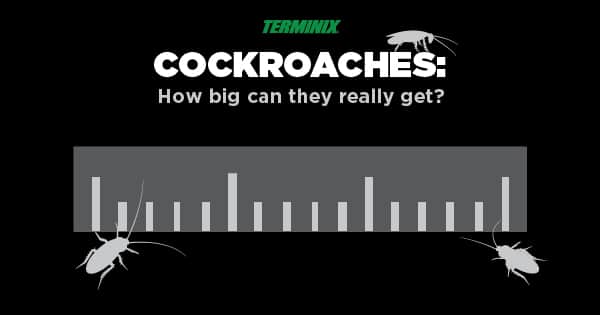There are few things human beings find more repugnant than cockroaches. And that visceral reaction is justified as cockroaches are unhygienic pests that can pose potential hazards to human health.

There are few things human beings find more repugnant than cockroaches. And that visceral reaction is justified as cockroaches are unhygienic pests that can pose potential hazards to human health.
Given its unwelcoming appearance, you may often wonder just how big can a cockroach get. The answer depends on its species (Texas alone is home to about 30 species) and its habitat.
Common Species of Cockroaches
Over 4,500 species of cockroaches span the globe, but some of the more common varieties found in the U.S. include the following:
American Cockroach (Periplaneta americana)
Also commonly known as "palmetto bugs," these indigenous roaches can grow to be one and a half to two inches in length. They are often found in sewers, boxes, storm drains and steam tunnels.
German cockroach (Blattella germanica)
German cockroaches are among the most widespread roaches in the world. Many a home, apartment and restaurant have battled an infestation of these bugs, which can be between one-eighth of an inch and half an inch in length.
Smoky brown cockroach (Periplaneta fuliginosa)
These roaches prefer the outdoors and are most frequently found in ground cover, mulch, palm fronds and tree holes. They can grow to be about an inch and a half.
Oriental cockroach (Blatta orientalis)
Commonly known as "water bugs," these cockroaches can grow to an inch in length. They like cool, damp environments, like woodpiles, ground cover, garages, basements, water meter boxes and drains.
Turkestan (Blatta lateralis)
This rusty red cockroach is considered a recent arrival to the U.S. and has rapidly spread eastward from California. Reaching lengths between half an inch to an inch, these highly adaptable imports make their homes in compost, leaf litter, potted plants, water meter boxes and cracks in concrete.
Life Cycle
When cockroaches breed, females deposit their eggs in cases known as oothecae. Most of these cases contains about 10–20 eggs, but the German cockroach contains 35-40. Nymphs (baby roaches) hatch from each egg and are small versions — one-fourth of an inch in length, on average — of adults. Unlike most adults, nymphs do not have wings.
Cockroaches are primarily nocturnal and prefer to hide in dark, warm, narrow spaces, coming out at night to scavenge for food. Despite growing to larger sizes, some adult cockroaches can hide in cracks only one-sixteenth of an inch wide.
Controlling Cockroaches
To help control cockroaches, you should start outside, around the perimeter of your home.
- Seal as many exterior cracks and holes as possible.
- Have a professional repair any structural damage around doors, windows, water pipes and baseboards.
- Use weather stripping around doors and windows.
- Make sure doors and windows fit securely inside their frames, and caulk the frames if needed.
- Remove trash, leaf litter and other items, such as lumber or firewood, that provide welcoming habitats for certain species of cockroach.
Inside your house, practice strict sanitation and remove readily available supplies of food and water for foraging cockroaches.
- Store dry goods in tight-sealing glass or plastic containers.
- Keep garbage and trash in receptacles equipped with tight-fitting lids.
- Remove trash, newspaper, magazines, rags, boxes and any other items that give cockroaches a place to hide and breed.
- Repair plumbing leaks and increase ventilation in areas where condensation from your HVAC system collects.
If your best DIY efforts are proving insufficient or if you want to help prevent cockroaches from infesting your home in the first place, call Terminix® and let our pest control professionals get to work.



